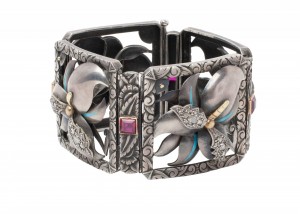In all my art and jewelry exploration, I’d never heard the term “Nuocentisme” before seeing a bracelet from this period on 1stdibs and then visiting Marta Alcolea’s gem (no pun intended) of an antique and estate jewelry store in Barcelona. Marta specializes in jewelry from this period.

From within the furnace of Barcelona, the capital of Catalonia, grew an art movement in the early 20th century that influenced painters, writers, architects, garden designers — and jewelers.
The movement, called Noucentisme, arose as a reaction to an earlier artistic period known as Moderisme, which was associated with modernist movements throughout Europe. Noucentisme reflected the Catalan aesthetic — which is, of course, in opposition to Spanish and European influences – and turned to the region’s spiritual roots.
Noucentisme has been poetically described as “a term without outlines, almost indefinable,” that pretends to gather “the palpitations of time.”
Painter Joaquín Sunyer described the characteristics of Noucentisme in a broad way:
- Imaginative art
- Intellectualism
- Art for art’s sake
- Order, perfection, beauty
One of the movement’s founders, a lawyer and artist named Eugeni D’Ors, believed that humankind wished to enter a new period of “morality” and that the ideal motto for a new society would be “the work well done.”
Noucentisme jewelry is muscular yet sensual, which might also describe Catalan nationalism. Artistically, the form espouses clear geometrical structures, harmony of all the parts and work that demonstrates careful design as opposed to impulsivity.
The materials often used in Noucentisme jewelry are rose cut diamonds, synthetic spinels, marcasite, synthetic sapphires, aquamarine and turquoise; and silver, gold and combinations of the two, with details of platinum. Enamels are used as highlights.
The pieces feature hammered surfaces with spirals and stepped figures. Rectangular forms are preferred to ovals.
Famous Noucentisme artists were writers — especially of poetry – architects, sculptors and painters.
Some created jewelry:
Ramón Sunyer i Clará, (1869-1963), is known as one of the greatest practitioners of Noucentista jewelry. He studied at the Francesc Galí Art School and with his father, metal smith Josep Sunyer i Parera. Sunyer combined forms of baroque and Romanesque with Cubism and Decó spirit to create a unique style that now bears his name. He founded the Arts and Crafts School of Barcelona and the Catalan Society of Historical Studies. He considered jewelry to be on the same artistic level as architecture and sculpture. In 1915, he chiseled the Medal of the Liturgical Congress of the Montserrat Virgin.
Jaume Mercadé i Queralt, (1887-1967), was a painter, metal smith and jeweler. He also studied at the Francesc Galí Art School and he became a professor of jewelry at the Arts and Crafts School in Barcelona. His work is renowned for its serenity and balance, framed by a restrained modernity. His baroque style was influenced by his visits to Paris, Munich and Berlin, which led him to use sheared plates and open geometric forms that he would enrich with different materials. Some of his paintings can be seen at the National Museum of Art of Cataluña along with jewelry made in collaboration with Emili Armengol i Gall and Manolo Hugué. He made rings, brooches and pendants that feature chiseling, patina and polishing.
Fuset y Grau was famous for his design of medallions and pendants of painted ivory, pearls, yellow gold and gems of different colors. He fashioned the backside of the jewelry from horn.
Manolo Hugué, (1872-1945), was a multifaceted artist, working as a sculptor, painter and jewelry designer known for a style in-between Noucentisme and Cubism He began designing jewelry after moving to a Catalan town for his health. In his art, the relationship with nature is essential and the human figure is an element integrated into the natural world. Such is a characteristic of much Noucentista art, but in hands of Hugué, it is sublime.
BIBLIOGRAPHY:
Arbeteta, L. La joyería española de Felipe II a Alfonso XIII en los museos estatales [catàleg de l’exposició] [The Spanish jewelry of Felipe II to Alfonso XIII in the state museums]. Editorial NEREA, 1998. Page 199.
Jiménez Priego, MªT. Joyería de los siglos XIX y XX [Jewelry in XIX and XX century]. UNED, 1997.
Menéndez Alzamora, M. La generación del 14. Una aventura intelectual. [The Generation of ’14. An intellectual adventure] Siglo XXI Editores, 2006. Page 509
VV.AA. Joies d’artista: del modernisme a l’avantguarda [catàleg de l’exposició]. MNAC, 2008.
VV.AA. La generación del 14 entre el Noucentisme i la Vanguardia (1906-1926) [The Generation of ’14 between the Noucentisme and the Vanguard]. Fundación Cultural Mapfre, 2002. Page 365.

